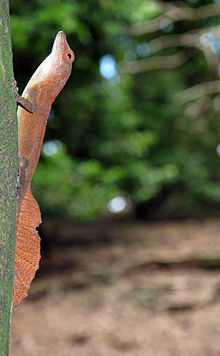Puerto Rican crested anole
| Puerto Rican crested anole | |
|---|---|
 | |
| A. c. cristatellus | |
| Scientific classification | |
| Kingdom: | Animalia |
| Phylum: | Chordata |
| Class: | Reptilia |
| Order: | Squamata |
| Suborder: | Iguania |
| Family: | Polychrotidae |
| Genus: | Anolis |
| Species: | A. cristatellus |
| Subspecies: | A. c. cristatellus |
| Trinomial name | |
| Anolis cristatellus cristatellus Duméril and Bibron, 1837 | |
The Puerto Rican crested anole (Anolis cristatellus cristatellus) is the nominate subspecies of a species of anole belonging to the Polychrotidae family of reptiles.
Geographic range
This lizard is found throughout Puerto Rico and has been introduced into eastern Hispaniola, Dominica, and Florida. Another subspecies, Anolis cristatellus wileyae, is found on islands off the eastern coast of Puerto Rico, such as Culebra and Vieques, and also on the U.S. Virgin Islands.
Habitat
These lizards normally stay in trees for protection. If a predator approaches, the male extends his dewlap and runs away. Some live under the sand.
Description
Coloration may vary significantly from a brownish-red to a dark black or a very light gray, and colors shift in reaction to temperature and behavioral state. They are often incorrectly referred to as "chameleons" because of their ability to slightly change color, but they are not related to true chameleons. They have a crest along the tail, probably serving to demonstrate dominance in a contest against another male for a female. The male has a bright yellow-orange dewlap which is also used in determining dominance when attempting to control territory. They usually are from 5-8 inches in length, but occasionally will grow up to 10 inches.
Behavior
When looking for a mate or defending its territory, this anole will display its dewlap and perform "push-ups" to establish dominance. Males aggressively defend territories when mating, but only rarely does this result in physical combat. As a defense against predators, they autotomize their tails.
Distribution
The Puerto Rican crested anole is found throughout Puerto Rico, except for some of the mountain regions of the island. They are also found on some of the offshore islands of Puerto Rico. They have been introduced into southern Florida and eastern Dominican Republic. They are sold in the pet trade, but are hard to find.
Diet
They mainly eat spiders and small invertebrates, but will occasionally eat fruit on the ground. They will sometimes even eat other anoles, due to territorial reasons, or if food is scarce.
See also
- List of amphibians and reptiles of Puerto Rico
- List of endemic fauna of Puerto Rico
- List of Anolis lizards